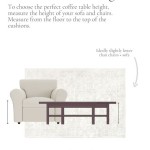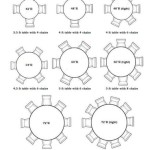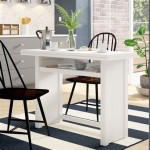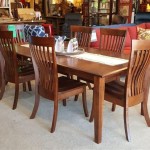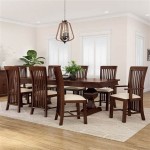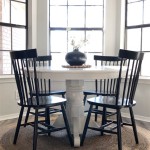Narrow Kitchen Tables: Maximizing Space in Compact Kitchens
The modern home, particularly in urban environments, often presents the challenge of limited square footage. The kitchen, a central hub for food preparation and often dining, can be particularly affected by space constraints. Narrow kitchen tables offer a practical solution for optimizing space while maintaining functionality. These tables are designed with reduced widths, allowing them to fit comfortably into smaller kitchens, galley kitchens, or even alcoves within larger living areas.
Selecting the right narrow kitchen table requires careful consideration of several factors, including the dimensions of the available space, the number of individuals who will regularly use the table, the desired style, and the materials used in construction. A well-chosen narrow kitchen table can transform a cramped kitchen into a more efficient and inviting space for meal preparation and dining.
The market offers a variety of narrow kitchen tables, each with its own unique features and benefits. Understanding the different types available, along with their pros and cons, is essential for making an informed decision.
Understanding Different Types of Narrow Kitchen Tables
Narrow kitchen tables are available in a range of styles and designs, catering to diverse aesthetic preferences and functional requirements. Some common types include drop-leaf tables, folding tables, pedestal tables, and console tables that can be repurposed for dining.
Drop-Leaf Tables: These versatile tables feature hinged leaves that can be folded down to save space when not in use. When more surface area is needed, the leaves can be easily extended, providing ample space for dining or food preparation. Drop-leaf tables are particularly well-suited for kitchens with fluctuating space needs, accommodating both small daily meals and larger gatherings.
Folding Tables: Similar to drop-leaf tables, folding tables can be collapsed and stored away when not needed. However, instead of hinged leaves, folding tables often have legs that fold inward, allowing the entire table to be stored flat against a wall or in a closet. This type of table is ideal for kitchens where space is at a premium and the table is only needed occasionally.
Pedestal Tables: Pedestal tables feature a single central support instead of four legs. This design can be advantageous in narrow spaces, as it eliminates the potential for bumping into legs, allowing for more comfortable seating and movement around the table. Additionally, pedestal tables often have a smaller footprint than traditional four-legged tables, making them well-suited for compact kitchens.
Console Tables: While not specifically designed as kitchen tables, narrow console tables can be repurposed for dining in small spaces. These tables typically have a narrow depth and can be placed against a wall to save space. When needed for dining, they can be pulled away from the wall and used with stools or chairs. Console tables offer a stylish and versatile solution for small kitchen spaces.
When selecting a narrow kitchen table, consider the overall design and functionality of the kitchen. The table should complement the existing décor and provide adequate space for meals and other activities. The material of the table should also be considered, as this will impact its durability and ease of maintenance.
Factors to Consider When Choosing a Narrow Kitchen Table
Selecting the right narrow kitchen table involves more than just choosing a style that aligns with personal taste. Several practical considerations must be taken into account to ensure the table meets the specific needs of the kitchen and its users.
Space Availability: The most crucial factor is the amount of space available in the kitchen. Measure the area where the table will be placed to ensure it fits comfortably without obstructing walkways or interfering with other kitchen activities. Consider the space needed for chairs or stools as well, ensuring ample room for movement around the table.
Number of Users: Determine how many people will typically use the table. A smaller table may suffice for individuals or couples, while larger families will require a table that can comfortably seat more people. Consider a table with extendable leaves or a drop-leaf design to accommodate occasional guests.
Material and Durability: The material of the table will impact its durability, aesthetics, and ease of maintenance. Common materials include wood, metal, glass, and laminate. Wooden tables offer a classic and warm look but may require more maintenance than other materials. Metal tables are durable and easy to clean, while glass tables can create a sense of spaciousness. Laminate tables are often cost-effective and resistant to stains and scratches.
Style and Aesthetics: The table should complement the overall style of the kitchen. Choose a table that blends seamlessly with the existing décor, whether it is modern, traditional, rustic, or contemporary. Consider the color, finish, and design of the table to ensure it enhances the overall aesthetic of the space.
Functionality: Consider how the table will be used beyond just dining. Will it also be used for food preparation, homework, or other activities? If so, choose a table that is durable and easy to clean. A table with storage options, such as drawers or shelves, can also be beneficial in small kitchens.
By carefully considering these factors, individuals can select a narrow kitchen table that meets their specific needs and enhances the functionality and aesthetics of their kitchen space.
Maximizing Space with Narrow Kitchen Table Placement
The placement of a narrow kitchen table is crucial for maximizing space and creating a functional and comfortable dining area. Strategic placement can significantly improve the flow of traffic within the kitchen and optimize the use of available space.
Placement Against a Wall: Placing a narrow kitchen table against a wall is a common strategy for saving space. This configuration minimizes the table's footprint and allows for more open space in the center of the kitchen. This approach is particularly effective with console tables or narrow rectangular tables.
Placement in a Corner: Utilizing a corner for the kitchen table can also be an effective space-saving technique. Corner tables or banquette seating can fit snugly into a corner, maximizing the use of often-overlooked space. This arrangement can create a cozy and intimate dining area.
Placement Near a Window: Placing the table near a window can create a bright and inviting dining area. Natural light can make the space feel larger and more open. This placement is particularly effective with small, round tables or pedestal tables.
Optimizing Chair Placement: The placement of chairs around the table is also important for maximizing space. Consider using backless stools or chairs that can be tucked under the table when not in use. This can help to keep walkways clear and prevent the space from feeling cluttered.
Considering Traffic Flow: Ensure that the table placement does not obstruct the flow of traffic within the kitchen. Avoid placing the table in high-traffic areas, such as near the stove or refrigerator. Aim to create a clear and unobstructed path through the kitchen.
Using Vertical Space: Maximize vertical space by adding shelving or cabinets above the table. This can provide additional storage for dishes, glassware, or other kitchen essentials. This strategy is particularly effective in small kitchens where counter space is limited.
Careful consideration of table placement and seating arrangements can significantly improve the functionality and aesthetics of a small kitchen. By implementing these space-saving strategies, individuals can create a comfortable and inviting dining area even in the most compact of spaces.
Ultimately, the selection of a narrow kitchen table is a decision that should be based on a comprehensive assessment of available space, functional requirements, and personal preferences. A well-chosen and strategically placed table can transform a small kitchen into a functional and stylish space for meal preparation and dining.

15 Narrow Dining Tables For Small Spaces

15 Narrow Dining Tables For Small Spaces

Kitchen Table Dining Set Bench Oak Wood Small To 8 Seater Space Saving Wooden Scandi 4 Seat Chairs Rustic Reclaimed Narrow Farmhouse Modern

15 Narrow Dining Tables For Small Spaces

Small Dining Rooms That Save Up On Space Decoist

Narrow Dining Table For Small Outlet Spaces

10 Narrow Dining Tables For A Small Room Modern

Narrow Dining Room Deals Table And Chairs

Narrow Kitchen Tables Clearance For Small Spaces

9 Ways To Fit A Table Into Cozy Kitchen

